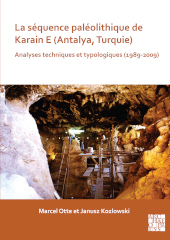2021 - Archaeopress Publishing
E-book
Digital Version
Download | Copy/paste | Printing
La séquence paléolithique de Karain E (Antalya, Turquie) : Analyses techniques et typologiques (1989-2009)
83 p.
- The long Palaeolithic sequence of Karain (Antalya, Turkey) began around 500,000 years ago and continued until the final Palaeolithic around 10,000 BC. This volume presents all the cultural and technical variations during this immense period, situated in a context which joins Africa, Asia, and Europe. In brief, the assemblage of tools appears to belong to Asian traditions; no Acheulian bifaces were observed. The earlier half of the sequence (stages 9 and 10) corresponds to centripetal industries with thick flakes and with denticulates and racloirs, classified as 'Proto-Charentian'. 'Modern archaic' human remains were sporadically discovered there. The upper phase is by far the most important: stages 8 to 5. These are superb Levallois industries with good quality exogenous materials. The tools are made from elongated flakes and transformed into racloirs with very elegant points. They have been termed 'Karain Mousterian'. Human remains are also associated with this phase (mandible and phalanges). The final phase
- (stage 4) is classically Mousterian with Neanderthal human remains. [Publisher's text].
-
Information


